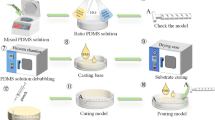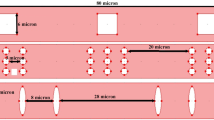Abstract
In this paper, we present elaborate study of design parameters of hybrid microfluidic mixer through numerical approach using finite element method and experimental studies to improve mixing efficiency in 3D printed lab on a chip. We investigated the change in mixing efficiency by varying passive parameters like intersection angle of the channel inlet V-leg, barrier shape, barrier orientation and the contours of the wall surface as well as the active parameters such as electric field, frequency and number of electrodes to change the electroosmotic flow-induced mixing behavior inside the mixing zone. The optimum design is then experimentally verified by using a 3D additive manufacturing printing technique to fabricate the mixing device. Analysis of Reynolds number versus mixing index indicates the efficiency to be better at lower flow rate while using electroosmotic mixing as well. The study of non-dimensional Peclet number reveals that four electrodes per side on the channel wall yield the maximum mixing within the operating range of this device. Putting it all together, the mixing efficiency reaches close to 50% when the barriers are staggered, waviness is absent in wall surface, intersection angle of the two inlets V-leg is close to 50° and the inlet flow rate is low. The optimal hybrid mixer design and implementation presented in this paper can enable further development of next generation 3D printed lab-on-chip devices.














Similar content being viewed by others
Abbreviations
- W :
-
Width of the channel (m)
- U 0 :
-
Mean flow velocity at inlet (m/s)
- u :
-
Flow velocity (m/s)
- p :
-
Pressure (Pa)
- ρ :
-
Fluid density (kg/m3)
- η :
-
Dynamic viscosity (kg/m s)
- εw = ε0εr :
-
Electric permittivity (F/m)
- ζ0 :
-
Zeta potential at the channel wall (V)
- V :
-
Potential (V)
- E:
-
Electric field (V/mm)
- σ :
-
Conductivity (S/m)
- (− σ∇V):
-
Current density (A/m2)
- c :
-
Concentration
- D :
-
Diffusion coefficient
- R :
-
Reaction rate
- T :
-
Transpose symbol
- ω:
-
Mass fraction
- λ :
-
Concentration mixing index
- Re :
-
Reynolds number
- Pe :
-
Peclet number
References
Adey WR (1993) Biological effects of electromagnetic fields. J Cell Biochem 51(4):410–416. https://doi.org/10.1002/jcb.2400510405
Ahamed MJ et al (2016) Continuous confinement fluidics: getting lots of molecules into small spaces with high fidelity. Macromolecules. https://pubs.acs.org/doi/abs/10.1021/acs.macromol.5b02617
Ahmed D, Mao X, Juluri BK, Huang TJ (2009) A fast microfluidic mixer based on acoustically driven sidewall-trapped microbubbles. Microfluid Nanofluid 7(5):727. https://doi.org/10.1007/s10404-009-0444-3
Aref H et al (1984) Stirring by chaotic advection. J Fluid Mech Camb Core. https://www.cambridge.org/core/journals/journal-of-fluid-mechanics/article/stirring-by-chaotic-advection/7B32CACE61D5AD79077846D7ACF4A31E
Bau HH et al (2001) A minute magneto hydro dynamic (MHD) mixer—ScienceDirect. https://www.sciencedirect.com/science/article/abs/pii/S0925400501008516
Biddiss E, Erickson D, Li D (2004) Heterogeneous surface charge enhanced micromixing for electrokinetic flows. Anal Chem 76(11):3208–3213. https://doi.org/10.1021/ac035451r
Branebjerg J, Gravesen P, Krog JP, Nielsen CR (1996) Fast mixing by lamination. In: Proceedings of ninth international workshop on micro electromechanical systems, pp 441–446. https://doi.org/10.1109/MEMSYS.1996.494022
Buchegger W, Wagner C, Lendl B, Kraft M, Vellekoop MJ (2011) A highly uniform lamination micromixer with wedge shaped inlet channels for time resolved infrared spectroscopy. Microfluid Nanofluid 10(4):889–897. https://doi.org/10.1007/s10404-010-0722-0
Cai G, Xue L, Zhang H, Lin J (2017) A review on micromixers. Micromachines 8(9):274. https://doi.org/10.3390/mi8090274
Chang C-C, Yang R-J (2004) Computational analysis of electrokinetically driven flow mixing in microchannels with patterned blocks. J Micromech Microeng 14(4):550–558. https://doi.org/10.1088/0960-1317/14/4/016
Chen C-H, Lin H, Lele SK, Santiago JG (2005) Convective and absolute electrokinetic instability with conductivity gradients. J Fluid Mech 524(February):263–303. https://doi.org/10.1017/S0022112004002381
Chen H, Yanting Z, Igor M, Carl M, Linda P (2008) Numerical Simulation of an electroosmotic micromixer. In: American Society of mechanical engineers digital collection, pp 653–658. https://doi.org/10.1115/imece2003-55017
Chen L, Deng Y, Zhou T, Pan H, Liu Z (2017) A novel electroosmotic micromixer with asymmetric lateral structures and DC electrode arrays. Micromachines 8(4):105. https://doi.org/10.3390/mi8040105
Choi E, Kim B, Park J (2009) High-throughput microparticle separation using gradient traveling wave dielectrophoresis. J Micromech Microeng 19(12):125014. https://doi.org/10.1088/0960-1317/19/12/125014
Cummings EB, Griffiths SK, Nilson RH, Paul PH (2000) Conditions for similitude between the fluid velocity and electric field in electroosmotic flow. Anal Chem 72(11):2526–2532. https://doi.org/10.1021/ac991165x
Electroosmotic Micromixer. COMSOL. “Electroosmotic Micromixer.” COMSOL Multiphysics®. COMSOL. https://www.comsol.com/model/electroosmotic-micromixer-485
Glasgow I, Aubry N (2003) Enhancement of microfluidic mixing using time pulsing. Lab Chip 3(2):114–120. https://doi.org/10.1039/B302569A
Gross BC et al (2014) Evaluation of 3D printing and its potential impact on biotechnology and the chemical sciences. Anal Chem. https://doi.org/10.1021/ac403397r
Hardt S, Schönfeld F (2003) Laminar mixing in different interdigital micromixers: II. Numerical simulations. AIChE J 49(3):578–584. https://doi.org/10.1002/aic.690490305
Ho CM, Benjamin SH, Ng KH, Li H, Yoon Y-J (2015) 3D printed microfluidics for biological applications. Lab Chip 15(18):3627–3637. https://doi.org/10.1039/C5LC00685F
Horn TJ, Harrysson OLA (2012) Overview of current additive manufacturing technologies and selected applications. Sci Prog 95(3):255–282. https://doi.org/10.3184/003685012X13420984463047
Hossain S, Husain A, Kim K-Y (2011) Optimization of micromixer with staggered herringbone grooves on top and bottom walls. Eng Appl Comput Fluid Mech 5(4):506–516. https://doi.org/10.1080/19942060.2011.11015390
Hsieh S-S, Lin J-W, Chen J-H (2013) Mixing efficiency of Y-type micromixers with different angles. Int J Heat Fluid Flow 44(December):130–139. https://doi.org/10.1016/j.ijheatfluidflow.2013.05.011
Huang M-Z, Yang R-J, Tai C-H, Tsai C-H, Lung-Ming F (2006) Application of electrokinetic instability flow for enhanced micromixing in cross-shaped microchannel. Biomed Microdev 8(4):309–315. https://doi.org/10.1007/s10544-006-0034-z
Huanming X, Jiawei W, Zhiping W (2018) A Comparative discussion of different designs of passive micromixers: specific sensitivities of mixing efficiency on reynolds numbers and fluid properties. Microsyst Technol 24(2):1253–1263. https://doi.org/10.1007/s00542-017-3496-4
Jen C-P, Chung-Yi W, Lin Y-C, Ching-Yi W (2003) Design and simulation of the micromixer with chaotic advection in twisted microchannels. Lab Chip 3(2):77–81. https://doi.org/10.1039/B211091A
Johnson TJ, Ross D, Locascio LE (2002) Rapid microfluidic mixing. Anal Chem 74(1):45–51. https://doi.org/10.1021/ac010895d
Khatavkar VV, Anderson PD, den Toonder JMJ, Meijer HEH (2007) Active micromixer based on artificial cilia. Phys Fluids 19(8):083605. https://doi.org/10.1063/1.2762206
Kim BS, Kwak BS, Shin S, Lee S, Kim KM, Jung H-I, Cho HH (2011) Optimization of microscale vortex generators in a microchannel using advanced response surface method. Int J Heat Mass Transf 54(1):118–125. https://doi.org/10.1016/j.ijheatmasstransfer.2010.09.061
Lee Y-K, Joanne D, Patrick T, Chih-Ming H (2001) Chaotic mixing in electrokinetically and pressure driven micro flows. In: Michael M, Wolfgang E, Jörg PB (eds) Microreaction technology. Springer, Berlin, pp 185–191. https://doi.org/10.1007/978-3-642-56763-6_20
Lee MG, Choi S, Park J-K (2009) Rapid laminating mixer using a contraction-expansion array microchannel. Appl Phys Lett 95(5):051902. https://doi.org/10.1063/1.3194137
Lee C-Y, Chang C-L, Wang Y-N, Lung-Ming F (2011) Microfluidic mixing: a review. Int J Mol Sci 12(5):3263–3287. https://doi.org/10.3390/ijms12053263
Lee C-Y, Wang W-T, Liu C-C, Lung-Ming F (2016) Passive mixers in microfluidic systems: a review. Chem Eng J 288(March):146–160. https://doi.org/10.1016/j.cej.2015.10.122
Liang-Hsuan L, Ryu KS, Liu C (2002) A magnetic microstirrer and array for microfluidic mixing. J Microelectromech Syst 11(5):462–469. https://doi.org/10.1109/JMEMS.2002.802899
Liolli A, Ahamed MJ (2017) Design of a hybrid active and passive efficient micromixer for 3D printed microfluidics. In: American Society of mechanical engineers digital collection. https://doi.org/10.1115/imece2016-68759
Liu RH, Stremler MA, Sharp KV, Olsen MG, Santiago JG, Adrian RJ, Aref H, Beebe DJ (2000) Passive mixing in a three-dimensional serpentine microchannel. J Microelectromech Syst 9(2):190–197. https://doi.org/10.1109/84.846699
Mahshid S, Ahamed MJ, Berard D, Amin S, Sladek R, Leslie SR, Reisner W (2015) Development of a platform for single cell genomics using convex lens-induced confinement. Lab Chip 15(14):3013–3020. https://doi.org/10.1039/C5LC00492F
Mark D, Haeberle S, Roth G, Von Stetten F, Zengerle R (2010) Microfluidic lab-on-a-chip platforms: requirements, characteristics and applications. In: Kakaç S, Kosoy B, Pramuanjaroenkij A (eds) Microfluidics based microsystems. NATO science for peace and security series a: chemistry and biology. Springer, Dordrecht, pp 305–376
Meijer HEH, Singh MK, Kang TG, den Toonder JMJ, Anderson PD (2009) Passive and active mixing in microfluidic devices. Macromol Symp 279(1):201–209. https://doi.org/10.1002/masy.200950530
Mengeaud V, Josserand J, Girault HH (2002) Mixing processes in a zigzag microchannel: finite element simulations and optical study. Anal Chem 74(16):4279–4286. https://doi.org/10.1021/ac025642e
Moctar AO, El NA, Batton J (2003) Electro-hydrodynamic micro-fluidic mixer. Lab Chip 3(4):273–280. https://doi.org/10.1039/B306868B
Niu X, Lee YK (2003) Efficient spatial-temporal chaotic mixing in microchannels. J Micromech Microeng 13(3):454–462
Oddy MH et al (2001) Electrokinetic instability micromixing. Anal Chem. https://doi.org/10.1021/ac0155411
Ottino JM, Wiggins SR, Wiggins S, Ottino JM (2004) Foundations of chaotic mixing. Philos Trans R Soc Lond Ser A Math Phys Eng Sci 362:937–970. https://doi.org/10.1098/rsta.2003.1356
Park JM, Seo KD, Kwon TH (2009) A chaotic micromixer using obstruction-pairs. J Micromech Microeng 20(1):015023. https://doi.org/10.1088/0960-1317/20/1/015023
Qian S, Bau HH (2002) A chaotic electroosmotic stirrer. Anal Chem 74(15):3616–3625. https://doi.org/10.1021/ac025601i
Qian S, Bau HH (2005) Theoretical investigation of electro-osmotic flows and chaotic stirring in rectangular cavities. Appl Math Model 29(8):726–753. https://doi.org/10.1016/j.apm.2004.10.006
Roudgar M, Brunazzi E, Galletti C, Mauri R (2012) Numerical study of split T-micromixers. Chem Eng Technol 35(7):1291–1299. https://doi.org/10.1002/ceat.201100611
Sahu PK, Golia A, Sen AK (2012) Analytical, numerical and experimental investigations of mixing fluids in microchannel. Microsyst Technol 18(6):823–832. https://doi.org/10.1007/s00542-012-1511-3
Seo HS, Kim YJ (2014) Effect of electrode positions on the mixing characteristics of an electroosmotic micromixer. J Nanosci Nanotechnol 14:6167–6171
Shallan AI, Smejkal P, Corban M, Guijt RM, Breadmore MC (2014) Cost-effective three-dimensional printing of visibly transparent microchips within minutes. Anal Chem 86(6):3124–3130. https://doi.org/10.1021/ac4041857
Song H, Bennett DJ (2011) Numerical study of enhancing the mixing effect in microchannels via transverse electroosmotic flow by placing electrodes on top and bottom of the channel. https://doi.org/10.1007/s00542-011-1318-7
Stone HA et al (2004) Engineering flows in small devices: microfluidics toward a lab-on-a-chip. Ann Rev Fluid Mech 36(1):381–411
Sudarsan AP, Ugaz VM (2006) Fluid mixing in planar spiral microchannels—lab on a chip (RSC Publishing) https://doi.org/10.1039/b511524h. https://pubs.rsc.org/en/content/articlehtml/2006/lc/b511524h
Tofteberg T, Skolimowski M, Andreassen E, Geschke O (2010) A novel passive micromixer: lamination in a planar channel system. Microfluid Nanofluid 8(2):209–215. https://doi.org/10.1007/s10404-009-0456-z
Tseng L-Y, Yang A-S, Lee C-Y, Hsieh C-Y (2011) CFD-based optimization of a diamond-obstacles inserted micromixer with boundary protrusions. Eng Appl Comput Fluid Mech 5(2):210–222. https://doi.org/10.1080/19942060.2011.11015365
Viktorov V, Nimafar M (2013) A novel generation of 3D SAR-based passive micromixer: efficient mixing and low pressure drop at a low reynolds number. J Micromech Microeng 23(5):055023. https://doi.org/10.1088/0960-1317/23/5/055023
Wang R, Lin J, Li H (2007) Chaotic mixing on a micromixer with barriers embedded. Chaos, Solitons Fractals 33(4):1362–1366. https://doi.org/10.1016/j.chaos.2006.01.099
Xu B, Wong TN, Nguyen N-T, Che Z, Chai JCK (2010) Thermal mixing of two miscible fluids in a T-shaped microchannel. Biomicrofluidics 4(4):044102. https://doi.org/10.1063/1.3496359
Yi M, Qian S, Bau HH (2002) A magnetohydrodynamic chaotic stirrer. J Fluid Mech 468(October):153–177. https://doi.org/10.1017/S0022112002001635
Zhang, YT, Chen H, Mezic I, Meinhart CD, Petzold L, MacDonald NC (2004) SOI processing of a ring electrokinetic chaotic micromixer. In: Proceedings of NSTI nanotechnology conference and trade show (Nanotech 2004), vol 1, pp 292–95
Zhou T, Xu Y, Liu Z, Joo SW (2015) An enhanced one-layer passive microfluidic mixer with an optimized lateral structure with the dean effect. J Fluids Eng. https://doi.org/10.1115/1.4030288
Zhou T, Wang H, Shi L, Liu Z, Joo SW (2016) An enhanced electroosmotic micromixer with an efficient asymmetric lateral structure. Micromachines 7(12):218. https://doi.org/10.3390/mi7120218
Acknowledgments
We would like to thank the Natural Sciences and Engineering Research Council of Canada (NSERC) Discovery Grants (RGPIN-04943) program for financial support. The authors would like to acknowledge CMC Microsystems for CAD tools support. AG would like to thank Indo-Canadian Institute for financial support.
Author information
Authors and Affiliations
Corresponding author
Additional information
Publisher's Note
Springer Nature remains neutral with regard to jurisdictional claims in published maps and institutional affiliations.
Rights and permissions
About this article
Cite this article
Agarwal, A., Salahuddin, A., Wang, H. et al. Design and development of an efficient fluid mixing for 3D printed lab-on-a-chip. Microsyst Technol 26, 2465–2477 (2020). https://doi.org/10.1007/s00542-020-04787-9
Received:
Accepted:
Published:
Issue Date:
DOI: https://doi.org/10.1007/s00542-020-04787-9




